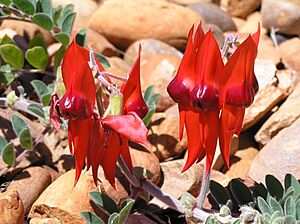Sturt's desert pea facts for kids
Quick facts for kids Sturt's Desert Pea |
|
|---|---|
 |
|
| Sturt's Desert Pea, at Melbourne Zoo | |
| Scientific classification | |
| Kingdom: | |
| (unranked): | |
| (unranked): | |
| (unranked): | |
| Order: | |
| Family: | |
| Subfamily: | |
| Tribe: | |
| Genus: |
Swainsona
|
| Species: |
S. formosa
|
| Binomial name | |
| Swainsona formosa (G. Don) Joy Thomps.
|
|
| Synonyms | |
|
|
The Sturt's Desert Pea (scientific name: Swainsona formosa) is a famous Australian plant. It is the special flower, or floral emblem, of South Australia. This beautiful plant was named after an explorer called Charles Sturt.
It belongs to the pea family, called Fabaceae. You can only find Sturt's Desert Pea growing in Australia, mostly in the dry parts of the country. An explorer named William Dampier was the first European to collect a sample of this plant in 1699. He found it in Western Australia.
Contents
What it Looks Like

Sturt's Desert Pea is a member of the pea family, Fabaceae. It has grey-green leaves that look like feathers (called pinnate). These leaves grow in a spiral pattern on the main stem. On the side stems, they grow in two opposite rows.
Its flowers look very different from other pea plants. They are about 9 centimetres long. These bright red flowers grow in groups of about six on thick, upright stalks. These stalks pop up every 10-15 centimetres along the plant's stems, which can spread up to 2 metres along the ground.
Inside the flower, there are parts for reproduction. These include 10 stamens (which make pollen). Nine of these are joined together, and one is separate. There is also an ovary (where seeds form) with a style and a stigma on top. The stigma receives pollen during fertilisation.
Life Cycle and Reproduction
This plant usually flowers from spring to summer, especially after it rains. You can find a natural pure white version of the flower. There are also mixed types (called hybridised) with flowers that can be blood red, pink, or even pale cream. These often have different coloured centres.
Some flowers have three colours. For example, marginata has a white bottom part with a red edge, a red top part, and a purple-black centre. The tricolour has a white bottom, a red top, and a pink centre. The elegans has a white top and bottom, both with red edges. Birds help to pollinate these flowers in the wild.
The plant produces a fruit called a legume, which is about 5 centimetres long. Each fruit holds 50 or more flat, kidney-shaped seeds when it is ready.
Naming History
The first samples of Sturt's Desert Pea were collected by William Dampier on August 22, 1699. These samples are now kept at the University of Oxford in England.
The way scientists classify this plant (its taxonomy) has changed over time. In the 1700s, it was first called Clianthus dampieri. Later, it became more widely known as Clianthus formosus. The word formosus is Latin for "beautiful."
However, a botanist named Joy Thompson later reclassified it. She moved it to the genus Swainsona, and it became Swainsona formosa. This is its official scientific name today.
The common name "Sturt's Desert Pea" honours Charles Sturt. He saw many of these flowers when he explored central Australia in 1844. The scientific name Swainsona honours a naturalist named Isaac Swainson.
Most Sturt's Desert Pea plants grow low to the ground. But in the Pilbara area of north-western Australia, some types have been seen growing as tall as 2 metres!
Growing the Plant
Sturt's Desert Pea is very good at living in the desert. Its seeds have a hard outer shell. This shell protects them from the harsh, dry environment until it rains. But this hard shell also makes it hard for the seeds to sprout in a normal garden.
To help the seeds grow, people can gently scratch the seed coat. They can also rub the seed with sandpaper. Another way is to put the seed in hot (almost boiling) water and let it soak overnight.
Once a seed sprouts, the young plant quickly grows a deep taproot. This deep root is very important for surviving in the desert. If you grow them at home, it's best to plant them where they will stay. Or, move them very soon after they sprout. They do not like their roots to be disturbed.
Once they are settled in soil that drains well, they do not need much water. They can handle extreme heat and sunshine, and even light frosts.
Sturt's Desert Pea is not an endangered plant. However, it is against the law to collect plants from public land without a special permit. You also need written permission from the owner to collect them from private land.
A Special Symbol
Sturt's Desert Pea was chosen as the floral emblem (special flower symbol) for the state of South Australia on November 23, 1961.
Because it is so well-known in Australia, especially in South Australia, it is often used in art and photos. You can also see it as a decoration and in many business logos. For example, it was once part of the logo for BankSA. It is also in the logo for the National Parks and Wildlife Service, South Australia.
Sturt's Desert Pea has also appeared in many stories and poems. It is even part of some Aboriginal legends. The flower has been on several Australian postage stamps that show Australian floral emblems (in 1968, 1971, and 2005). The flower is also on the logo of Charles Sturt University, which is also named after the explorer.


